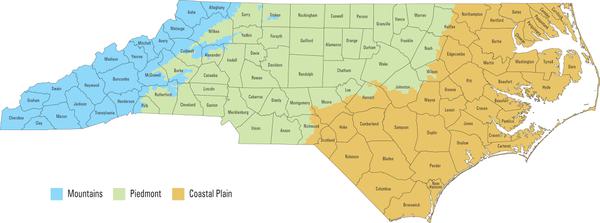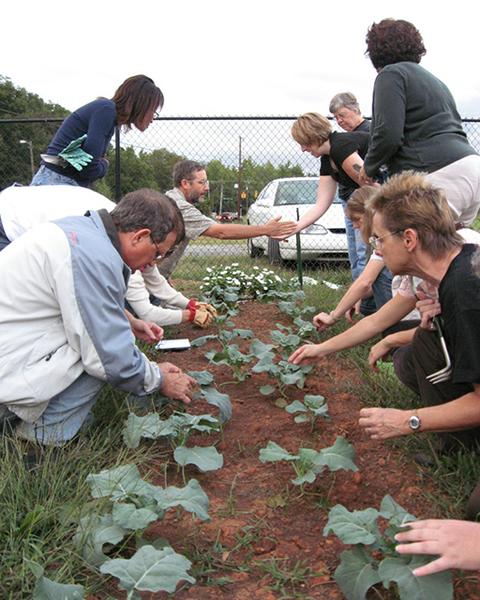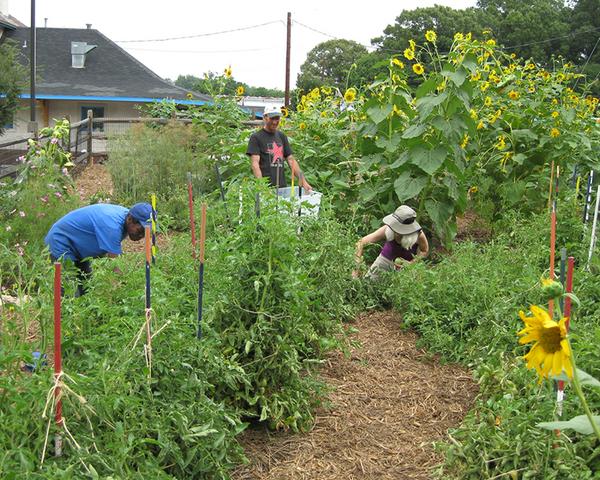Good gardening practices are essential to the success of community food gardens. Successful gardeners who reap a bounty of good food from their garden plots will stick with the garden. If their garden fails to produce a harvest they may become discouraged and give up.
Despite the importance of the topic, this chapter on specific techniques for growing food is brief, limited to a handful of specific issues relevant to community gardeners. General information on vegetable gardening is easy to find, and the NC State Extension Gardening portal is an excellent resource.
Learning about Growing Food
Gardeners can become more successful by learning more about gardening. Dozens of popular gardening books, TV shows, and websites compete for public attention, each claiming to have the newest and best techniques for growing garden vegetables. A handful of these resources have become extremely influential among community gardeners, such as Square Foot Gardening (Bartholomew 1981) and Lasagna Gardening (Lanza 1998). Permaculture (Mollison and Holmgren 1978; Hemenway 2009) a complex, ecologically-based food production and landscape design system, has passionate adherents, as does the biodynamic method (Steiner, 1928; Pfeiffer, 1938) and French-Intensive/Biodynamic based on the gardening practices of Alan Chadwick (Jeavons 1974). Each approach has virtues and shortcomings. Draw on NC State Extension, Carolina Farm Stewardship Association, The Center for Environmental Farming Systems, and other researchers for a broad view, emphasizing research-based, ecologically sound gardening methods. Experienced local gardeners and farmers, and community gardeners themselves, can also be outstanding resources.
Individual gardeners in plot gardens should be free to use any technique they prefer, so long as it does not adversely affect the rest of the garden (particularly their immediate neighbors) or gardeners who might use their plot after them.
NC State Extension
NC State Extension offers a wealth of expertise on growing vegetables. Start your search at NC State Extension Gardening portal. NC State Extension Master GardenerSM volunteers receive training in fruit and vegetable gardening and community gardening. Contact your local Extension center to request an Extension Master Gardener mentor for your garden. Extension Master Gardener volunteers can be contacted online or by phone at your local Extension center.
Local Farmers and Gardeners as Resources
Experienced gardeners and farmers in the community are also excellent information sources. They are often pleased to be asked for advice and will generously share information about best varieties, timing, and techniques. Local hardware and feed stores, which have been dispensing good advice and good seeds to the gardeners in their communities for generations, are another great source of information. Seek out such local assets and support them.
A growing number of community colleges offer classes on vegetable production. Continuing education courses designed for home vegetable gardening are inexpensive, locally-oriented, and offer a good starting point. Another source of valuable technical information and networking is the Carolina Farm Stewardship Association and the North Carolina Organic Growers Schools.
Within a community food garden, it is easy to spot an experienced gardener’s plot, full of flowers and healthy crops. These gardeners can become valuable resources building relationships across generations and between cultures. Many of the best gardeners are older gardeners or recent immigrants who grew up on a farm or working in the fields. The knowledge they gained working the land is invaluable in the garden.
Learning in the Garden
The best way to learn to garden is by gardening. Help the garden become a learning community where gardeners share what they learn and pool resources to research questions. Encourage gardeners to keep a garden journal. Set up classes and discussion groups about various aspects of food growing and host them at the garden, inviting both gardeners and the community to attend.
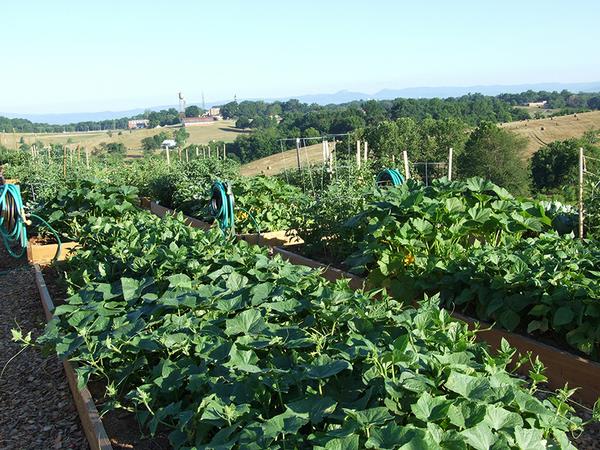
Donna Teasley CC BY-SA 4.0
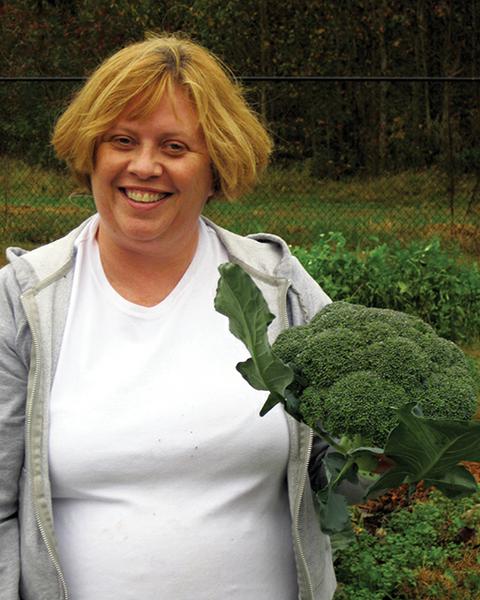
Don Boekelheide CC BY 4.0
Vegetable Growing Calendar
North Carolina’s long growing season, even in the mountains, allows community food gardeners to enjoy months of fresh produce from their garden plots. However, timing is critical for success in the vegetable garden.
In the piedmont and coastal plain, there are three overlapping seasons (see Table 1). Cool-season vegetables such as cabbage and lettuce thrive in both spring and fall. Warm-season vegetables, such as tomatoes and green beans, need to wait until the soil warms after the average last spring frost date (April 15 in the central piedmont). See Average Last Spring Frost Dates for Selected North Carolina Locations for more information. Beginning gardeners may not be aware of these timing requirements and need gentle reminders. Garden centers do not always offer wise choices on their shelves.
To save gardeners money, increase choices, and provide good community building opportunities, consider growing your own transplants. Start seeds early indoors or in a greenhouse and use season extenders. Starting seeds under florescent bulbs or in a greenhouse can provide gardeners with healthy seedlings in time for planting in the spring. Seedlings need to be started early enough, however, (meaning February and March, if not January) for spring cool season starts.
| SPRING | SUMMER | FALL |
|---|---|---|
| (February) | (April 15 and after) | (early to mid-August) |
| peas | amaranth, callaloo | arugula |
| basil | beets | |
| (early to mid-March) | beans, green beans | bok choy |
| arugula | squash, summer | broccoli |
| beets | squash, winter | Brussels sprouts |
| bok choy (transplants) | sweet corn | cabbage |
| broccoli | tomatoes | cabbage, Asian |
| cabbage | carrots | |
| cabbage, Asian | (late April/early May) | cilantro |
| carrots | beans, lima | greens, Asian |
| cilantro | black-eyed peas | greens, collards |
| greens, Asian | cucumbers | greens, mustard |
| greens, collards | eggplant | kale |
| greens, mustard | melons | kohlrabi |
| kale | okra | lettuce |
| kohlrabi | peas, southern | onions, green |
| lettuce | peppers | parsley |
| onions, bulb | pumpkins | radish |
| onions, green | spinach | salad mix, mesclun |
| parsley | spinach, Malabar | spinach |
| potatoes | watermelon | Swiss chard |
| radish | turnips | |
| salad mix, mesclun | (mid-May/June) | |
| spinach | beans, edamame/soy | (mid-October) |
| Swiss chard | sweetpotato | garlic |
| turnips | ||
| Based on Bradley et al. (2012), Jones and Roos (2007). | ||
NOTE: As a general rule of thumb, for the coastal plain, where it warms up sooner and stays warm longer, you can begin two weeks earlier in the spring, and continue two weeks later into the fall. For the mountains and foothills where winter lasts longer and comes earlier, it is safer to begin two weeks later in the spring and quit planting two weeks earlier in the fall. See Figure 2 to identify the regions. Also see planting calendars for each region:
- Eastern North Carolina Planting Calendar for Annual Vegetables, Fruits, and Herbs, AG-756-02
- Central North Carolina Planting Calendar for Annual Vegetables, Fruits, and Herbs, AG-756-01
- Western North Carolina Planting Calendar for Annual Vegetables, Fruits, and Herbs, AG-756-03
Season extension techniques allow crops to be grown outside their usual growing season, providing an earlier start and a longer harvest period. Frost cloth, high tunnels, and greenhouses can provide protection from the cold in late fall, winter, and early spring. Shade cloth can protect from high heat and solar intensity in summer. These techniques, coupled with wise variety selection, make it possible to have fresh food from the garden for much of the year.
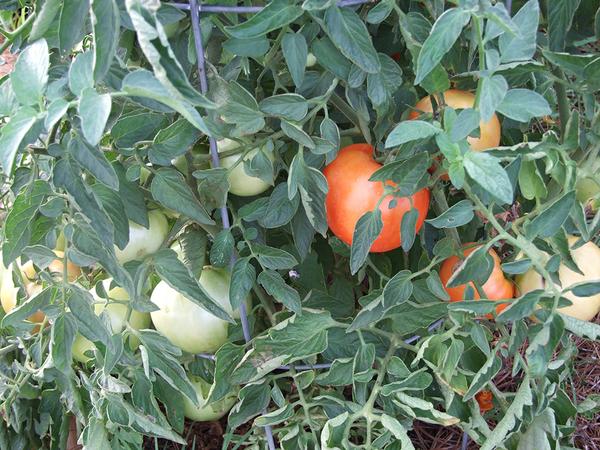
Donna Teasley CC BY-SA 4.0
Fertilization
Vegetables are fast-growing, high-demand plants that yield significantly more when optimum amounts of plant nutrients are available in the soil. Fertilizer is a natural or synthetic material with a concentrated source of plant nutrients.
Commercial fertilizers are labeled with three numbers. The first number is the percentage of nitrogen, the second is the percentage of phosphorus, and the third is the percentage of potassium. For example, bone meal is labeled 4–12–0: 4% nitrogen, 12% phosphorous, and 0% potassium. An Extension agent or other qualified individual can help develop a straight-forward fertilization plan to guide the amount and timing of fertilizer applications based on soil test results, nutrient needs of specific crops, past fertilizer applications, and other factors.
Organic fertilizers are made from a wide variety of naturally occurring materials, such as fish, blood, bone, feather, manure, and plant materials. Organic fertilizers have a number of advantages: they are readily available and sometimes inexpensive or free; they release nutrients slowly over time; they provide micronutrients and soil microbes; and they improve soil structure. There are also disadvantages to organic fertilizers: sometimes they don’t act quickly enough to address a critical deficiency, the nutrient contents may vary, they can be bulky and difficult to store, and some can be quite expensive, especially in small quantities.
Synthetic fertilizers are manufactured and come in powder, pellet, granular, and liquid forms. They include sodium nitrate, potassium chloride, ammonium sulfate, and many others. These fertilizers are widely available, quick-acting, easy to use, and often inexpensive. However, the manufacturing process is energy intensive and produces pollution, and overuse can damage microorganisms in the soil and pollute streams, rivers, lakes, and groundwater via stormwater runoff.
Compost is helpful for both approaches for fertilization. It increases soil organic matter and the ability of the soil to retain nutrients, and it stimulates beneficial soil ecology and microorganisms, making fertilizer use more efficient.
If a garden chooses to be organic, garden leadership and sponsors should clarify exactly what organic means in the context of the garden and whether organic methods will be required in the entire garden or only in a specific location within the garden. The USDA’s National Organic Program (NOP) rules for organic certification and the Organic Materials Research Institute (OMRI) rules provide a logical starting point, though community gardeners may want to adapt these guidelines to fit their needs and expectations. For more information on organic gardening, see the North Carolina Extension Gardener Handbook, AG-831.
Fertilizing Raised-Bed Planters
Gardeners using raised beds should also add fertilizer on a seasonal basis to match the needs of each crop. They must be especially careful, however, to not over-apply, which is easy to do with a limited volume of soil. Avoid fertilizer materials with high salt values.
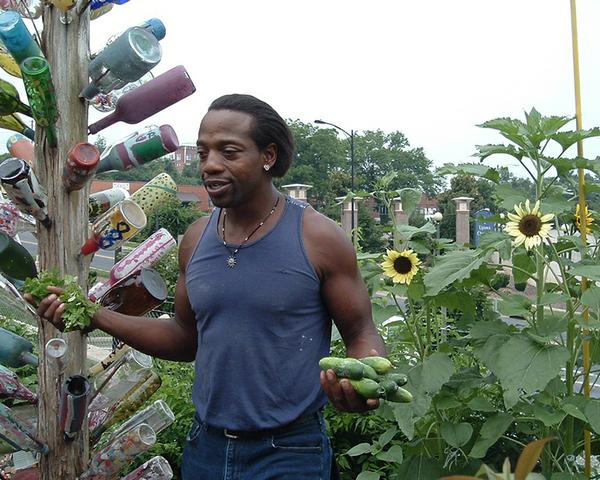
Don Boekelheide CC BY 4.0
Planting Strategies
Gardeners with individual plots usually are most interested in putting food on the table. For that reason, they may favor old-fashioned and heirloom varieties that give an ongoing harvest throughout the growing season. They may also plant small amounts of certain crops every three or four weeks to ensure a continuous supply of fresh produce (for instance, arugula, lettuce, radishes, bush green beans, and tomatoes).
A cooperative garden must keep harvesting demands in mind and be able to mobilize enough people to pick and process the harvest at peak quality. In these cases, gardeners may focus on agricultural varieties bred for uniform ripening to facilitate mass harvest (such as determinate tomatoes, heading cabbage, lettuce, and sweet corn).
Cooperative food gardens should let the food preferences of those receiving the vegetables guide the choice of what to grow. Collard greens and Irish potatoes may be much more popular in donated food baskets or the soup kitchen than arugula and mesclun mix.
If the cooperative garden’s goal is to earn money, however, such high value gourmet crops may be the better choice. If the garden plans to sell to restaurants and farmers markets, conscientiously look for a niche and set fair prices that do not compete with or undercut local small farmers.
Post-Harvest Handling
If the garden is large, set aside an area to clean and properly handle and refrigerate produce after harvest. Proper produce handling is essential to ensuring food safety and is required if the garden wishes to sell or donate the food it produces. These practices are beneficial for all gardens. For more detailed information, see chapter 10, Food Safety and Garden Health.
Publication date: Aug. 10, 2017
AG-806
Other Publications in Collard Greens and Common Ground: A North Carolina Community Food Gardening Handbook
N.C. Cooperative Extension prohibits discrimination and harassment regardless of age, color, disability, family and marital status, gender identity, national origin, political beliefs, race, religion, sex (including pregnancy), sexual orientation and veteran status.

